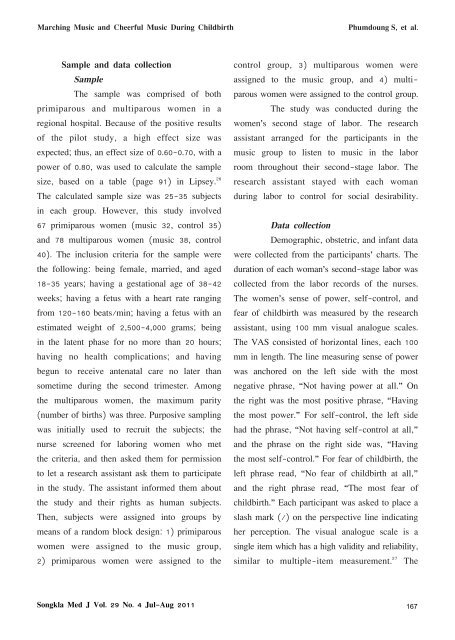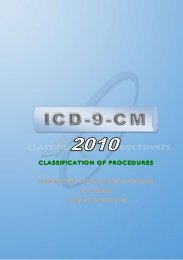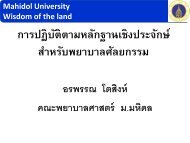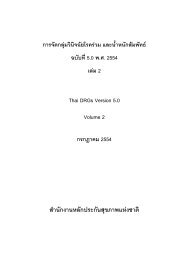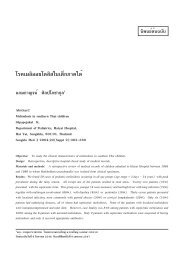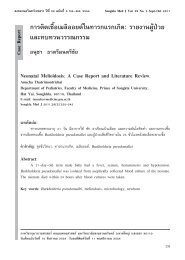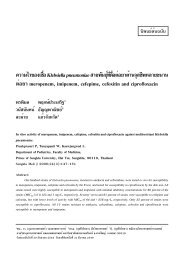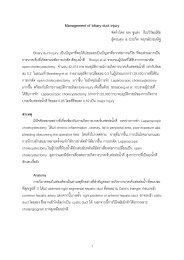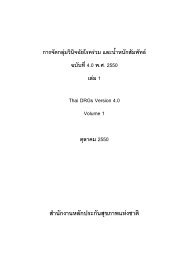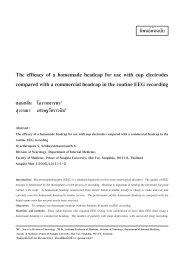The Effects of Instrumental Marching and Cheerful Music on ...
The Effects of Instrumental Marching and Cheerful Music on ...
The Effects of Instrumental Marching and Cheerful Music on ...
- No tags were found...
Create successful ePaper yourself
Turn your PDF publications into a flip-book with our unique Google optimized e-Paper software.
<str<strong>on</strong>g>Marching</str<strong>on</strong>g> <str<strong>on</strong>g>Music</str<strong>on</strong>g> <str<strong>on</strong>g>and</str<strong>on</strong>g> <str<strong>on</strong>g>Cheerful</str<strong>on</strong>g> <str<strong>on</strong>g>Music</str<strong>on</strong>g> During ChildbirthPhumdoung S, et al.Sample <str<strong>on</strong>g>and</str<strong>on</strong>g> data collecti<strong>on</strong>Sample<str<strong>on</strong>g>The</str<strong>on</strong>g> sample was comprised <str<strong>on</strong>g>of</str<strong>on</strong>g> bothprimiparous <str<strong>on</strong>g>and</str<strong>on</strong>g> multiparous women in aregi<strong>on</strong>al hospital. Because <str<strong>on</strong>g>of</str<strong>on</strong>g> the positive results<str<strong>on</strong>g>of</str<strong>on</strong>g> the pilot study, a high effect size wasexpected; thus, an effect size <str<strong>on</strong>g>of</str<strong>on</strong>g> 0.60-0.70, with apower <str<strong>on</strong>g>of</str<strong>on</strong>g> 0.80, was used to calculate the samplesize, based <strong>on</strong> a table (page 91) in Lipsey. 26<str<strong>on</strong>g>The</str<strong>on</strong>g> calculated sample size was 25-35 subjectsin each group. However, this study involved67 primiparous women (music 32, c<strong>on</strong>trol 35)<str<strong>on</strong>g>and</str<strong>on</strong>g> 78 multiparous women (music 38, c<strong>on</strong>trol40). <str<strong>on</strong>g>The</str<strong>on</strong>g> inclusi<strong>on</strong> criteria for the sample werethe following: being female, married, <str<strong>on</strong>g>and</str<strong>on</strong>g> aged18-35 years; having a gestati<strong>on</strong>al age <str<strong>on</strong>g>of</str<strong>on</strong>g> 38-42weeks; having a fetus with a heart rate rangingfrom 120-160 beats/min; having a fetus with anestimated weight <str<strong>on</strong>g>of</str<strong>on</strong>g> 2,500-4,000 grams; beingin the latent phase for no more than 20 hours;having no health complicati<strong>on</strong>s; <str<strong>on</strong>g>and</str<strong>on</strong>g> havingbegun to receive antenatal care no later thansometime during the sec<strong>on</strong>d trimester. Am<strong>on</strong>gthe multiparous women, the maximum parity(number <str<strong>on</strong>g>of</str<strong>on</strong>g> births) was three. Purposive samplingwas initially used to recruit the subjects; thenurse screened for laboring women who metthe criteria, <str<strong>on</strong>g>and</str<strong>on</strong>g> then asked them for permissi<strong>on</strong>to let a research assistant ask them to participatein the study. <str<strong>on</strong>g>The</str<strong>on</strong>g> assistant informed them aboutthe study <str<strong>on</strong>g>and</str<strong>on</strong>g> their rights as human subjects.<str<strong>on</strong>g>The</str<strong>on</strong>g>n, subjects were assigned into groups bymeans <str<strong>on</strong>g>of</str<strong>on</strong>g> a r<str<strong>on</strong>g>and</str<strong>on</strong>g>om block design: 1) primiparouswomen were assigned to the music group,2) primiparous women were assigned to thec<strong>on</strong>trol group, 3) multiparous women wereassigned to the music group, <str<strong>on</strong>g>and</str<strong>on</strong>g> 4) multiparouswomen were assigned to the c<strong>on</strong>trol group.<str<strong>on</strong>g>The</str<strong>on</strong>g> study was c<strong>on</strong>ducted during thewomen’s sec<strong>on</strong>d stage <str<strong>on</strong>g>of</str<strong>on</strong>g> labor. <str<strong>on</strong>g>The</str<strong>on</strong>g> researchassistant arranged for the participants in themusic group to listen to music in the laborroom throughout their sec<strong>on</strong>d-stage labor. <str<strong>on</strong>g>The</str<strong>on</strong>g>research assistant stayed with each wom<str<strong>on</strong>g>and</str<strong>on</strong>g>uring labor to c<strong>on</strong>trol for social desirability.Data collecti<strong>on</strong>Demographic, obstetric, <str<strong>on</strong>g>and</str<strong>on</strong>g> infant datawere collected from the participants’ charts. <str<strong>on</strong>g>The</str<strong>on</strong>g>durati<strong>on</strong> <str<strong>on</strong>g>of</str<strong>on</strong>g> each woman’s sec<strong>on</strong>d-stage labor wascollected from the labor records <str<strong>on</strong>g>of</str<strong>on</strong>g> the nurses.<str<strong>on</strong>g>The</str<strong>on</strong>g> women’s sense <str<strong>on</strong>g>of</str<strong>on</strong>g> power, self-c<strong>on</strong>trol, <str<strong>on</strong>g>and</str<strong>on</strong>g>fear <str<strong>on</strong>g>of</str<strong>on</strong>g> childbirth was measured by the researchassistant, using 100 mm visual analogue scales.<str<strong>on</strong>g>The</str<strong>on</strong>g> VAS c<strong>on</strong>sisted <str<strong>on</strong>g>of</str<strong>on</strong>g> horiz<strong>on</strong>tal lines, each 100mm in length. <str<strong>on</strong>g>The</str<strong>on</strong>g> line measuring sense <str<strong>on</strong>g>of</str<strong>on</strong>g> powerwas anchored <strong>on</strong> the left side with the mostnegative phrase, “Not having power at all.” Onthe right was the most positive phrase, “Havingthe most power.” For self-c<strong>on</strong>trol, the left sidehad the phrase, “Not having self-c<strong>on</strong>trol at all,”<str<strong>on</strong>g>and</str<strong>on</strong>g> the phrase <strong>on</strong> the right side was, “Havingthe most self-c<strong>on</strong>trol.” For fear <str<strong>on</strong>g>of</str<strong>on</strong>g> childbirth, theleft phrase read, “No fear <str<strong>on</strong>g>of</str<strong>on</strong>g> childbirth at all,”<str<strong>on</strong>g>and</str<strong>on</strong>g> the right phrase read, “<str<strong>on</strong>g>The</str<strong>on</strong>g> most fear <str<strong>on</strong>g>of</str<strong>on</strong>g>childbirth.” Each participant was asked to place aslash mark (/) <strong>on</strong> the perspective line indicatingher percepti<strong>on</strong>. <str<strong>on</strong>g>The</str<strong>on</strong>g> visual analogue scale is asingle item which has a high validity <str<strong>on</strong>g>and</str<strong>on</strong>g> reliability,similar to multiple-item measurement. 27 <str<strong>on</strong>g>The</str<strong>on</strong>g>S<strong>on</strong>gkla Med J Vol. 29 No. 4 Jul-Aug 2011 167


